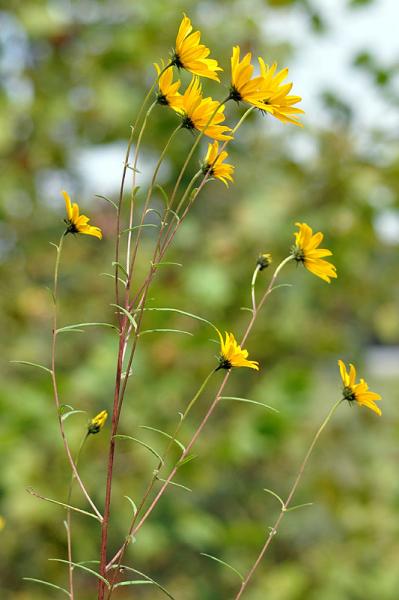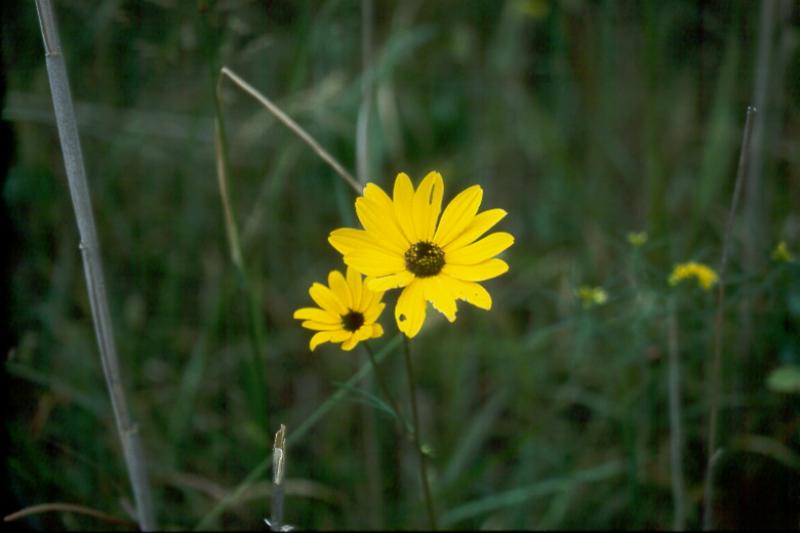Swamp Sunflower
Helianthus angustifolius L.
- Class
- Dicotyledoneae (Dicots)
- Family
- Asteraceae (Aster Family)
- State Protection
- Threatened
Listed as Threatened by New York State: likely to become Endangered in the foreseeable future. For animals, taking, importation, transportation, or possession is prohibited, except under license or permit. For plants, removal or damage without the consent of the landowner is prohibited.
- Federal Protection
- Not Listed
- State Conservation Status Rank
- S2
Imperiled in New York - Very vulnerable to disappearing from New York due to rarity or other factors; typically 6 to 20 populations or locations in New York, very few individuals, very restricted range, few remaining acres (or miles of stream), and/or steep declines.
- Global Conservation Status Rank
- G5
Secure globally - Common in the world; widespread and abundant (but may be rare in some parts of its range).
Summary
Did you know?
This species has the most narrow leaves of any member of the sunflower genus in the northeastern United States. It is also the only one that grows in salt marshes.
State Ranking Justification
There are seven existing populations but many of them are threatened due to displacement by Phragmites. There are 31 historical occurrences. Most of them have been resurveyed but no plants were found.
Short-term Trends
This species is declining rapidly as Phragmites takes over the salt marsh and brackish meadow habitats.
Long-term Trends
The species has been in severe decline over the last 100 years because many coastal habitats have been developed or drained and the remaining marshes are being taken over by Phragmites.
Conservation and Management
Threats
The invasion of Phragmites is the major threat to this species and it may have eliminated some populations.
Conservation Strategies and Management Practices
Phragmites needs to be prevented from getting close to the remaining large populations.
Research Needs
We need to know the best way to protect the species from Phragmites.
Habitat
Habitat
This sunflower is found in open wetlands near the ocean which usually contain some influence of salt water although they may be tending towards more freshwater. These meadows and marshes have a high diversity of species but have been taken over by Phragmites in recent years.
Associated Ecological Communities
- Brackish interdunal swales
(guide)
Temporarily tidally flooded temperate marshes in interdunal swales dominated by salt-tolerant graminoids. Individual swales occur as small patches positioned between fore-, primary and secondary dunes in a maritime dunes system, typically on barrier islands.
- Brackish meadow
(guide)
A moist, moderately well-drained brackish (salinity 0.5-18 ppt) perennial grassland with occasional isolated shrubs that is typically situated in a belt at the upper edge of salt marshes bordering sandy uplands, but may occupy large portions of interdunal basins. The community usually develops in areas with a unique combination of soils and hydrology, on deep deposits of periodically windblown or overwashed gleyed sands that are usually flooded only during spring tides and during major coastal storms, approximately two to three times per year.
- High salt marsh
(guide)
A coastal marsh community that occurs in sheltered areas of the seacoast, in a zone extending from mean high tide up to the limit of spring tides. It is periodically flooded by spring tides and flood tides. High salt marshes typically consist of a mosaic of patches that are mostly dominated by a single graminoid species.
- Maritime freshwater interdunal swales
(guide)
A mosaic of wetlands that occur in low areas between dunes along the Atlantic coast; the low areas (swales) are formed either by blowouts in the dunes that lower the soil surface to groundwater level, or by the seaward extension of dune fields. Water levels fluctuate seasonally and annually. Sedges and herbs are usually the most abundant types of plants. These wetlands may be quite small (less than 0.25 acre).
Associated Species
- Acer rubrum
- Agalinis purpurea (purple agalinis)
- Andropogon virginicus
- Asclepias incarnata
- Calystegia sepium (hedge bindweed)
- Chelone glabra (white turtle-head)
- Cirsium horridulum
- Cladium mariscoides (twig-rush)
- Euthamia caroliniana (slender flat-topped-goldenrod)
- Fimbristylis autumnalis (autumn fimbry)
- Impatiens capensis (spotted jewelweed, spotted touch-me-not)
- Iris prismatica (slender blue iris, slender blue flag)
- Juncus scirpoides
- Lobelia cardinalis (cardinal flower)
- Nyssa sylvatica (black-gum, sour-gum)
- Panicum virgatum (switch grass)
- Persicaria arifolia (halberd-leaved tear-thumb)
- Photinia melanocarpa
- Phragmites australis (old world reed grass, old world phragmites)
- Polygala cruciata (cross-leaved milkwort)
- Ptilimnium capillaceum (mock bishopweed)
- Rhus copallinum
- Rhynchospora capitellata (brownish beak sedge)
- Sabatia campanulata (slender marsh-pink)
- Solidago sempervirens (northern seaside goldenrod)
- Symphyotrichum dumosum (bushy-aster)
- Symphyotrichum tenuifolium
- Thelypteris palustris
- Vaccinium corymbosum (highbush blueberry)
- Vaccinium macrocarpon (cranberry)
- Vernonia noveboracensis (New York ironweed)
- Viburnum dentatum
Range
New York State Distribution
This sunflower is currently known from Suffolk County on Long Island but once ranged west to New York City and Staten Island where it is now considered extirpated. It is historically known from Nassau County.
Global Distribution
This is primarily a species of the southeastern US where it extends southwest to Arkansas and Oklahoma, eastern Texas, and Louisiana. To the west it grows in just a few counties of southern Illinois and Missouri. Its northeastern limits extend to the Delmarva Peninsula, southern New Jersey, and to Long Island. It is considered rare outside of the Southeast and Southwest. It has been extirpated from the coastal plain of Pennsylvania.
Identification Comments
General Description
This sunflower has solitary hairy stems which grow from 0.5 up to 2 meters tall. The numerous leaves are sessile and linear with margins that are turned under.They are 10-30 times as long as wide, dark green and rough on the upper side. The yellow ray flowers surround a purple disk.
Best Life Stage for Proper Identification
This plant can be identified in vegetative condition but it is more easily seen when in flower.
Similar Species
There is no other sunflower that has these very narrow leaves and grows in salt water-influenced habitats.
Best Time to See
The vegetative stems grow during the summer and flowering begins in July. Flowers can be seen through the first part of September and fruits through November.
- Flowering
- Fruiting
The time of year you would expect to find Swamp Sunflower flowering and fruiting in New York.
Swamp Sunflower Images
Taxonomy
Swamp Sunflower
Helianthus angustifolius L.
- Kingdom Plantae
- Phylum Anthophyta
- Class Dicotyledoneae
(Dicots)
- Order Asterales
- Family Asteraceae (Aster Family)
- Order Asterales
- Class Dicotyledoneae
(Dicots)
- Phylum Anthophyta
Additional Resources
Best Identification Reference
Flora of North America Editorial Committee. 2006. Flora of North America North of Mexico. Vol. 21. Magnoliophyta: Asteridae, Part 8: Asteraceae, part 3. Oxford Univ. Press, New York. xxii + 616 pp.
Other References
Clemants, Steven and Carol Gracie. 2006. Wildflowers in the Field and Forest. A Field Guide to the Northeastern United States. Oxford University Press, New York, NY. 445 pp.
Fernald, M.L. 1950. Gray's manual of botany. 8th edition. D. Van Nostrand, New York. 1632 pp.
Gleason, Henry A. and A. Cronquist. 1991. Manual of Vascular Plants of Northeastern United States and Adjacent Canada. The New York Botanical Garden, Bronx, New York. 910 pp.
Holmgren, Noel. 1998. The Illustrated Companion to Gleason and Cronquist's Manual. Illustrations of the Vascular Plants of Northeastern United States and Adjacent Canada. The New York Botanical Garden, Bronx, New York.
New York Natural Heritage Program. 2010. Biotics database. New York Natural Heritage Program. New York State Department of Environmental Conservation. Albany, NY.
New York Natural Heritage Program. 2024. New York Natural Heritage Program Databases. Albany, NY.
Newcomb, Lawrence. 1977. Newcomb's Wildflower Guide: An Ingenious New Key System for Quick, Positive Field Identification of the Wildflowers, Flowering Shrubs, and Vines of Northeastern and North-Central North America. Little, Brown and Company. Boston.
Weldy, T. and D. Werier. 2010. New York flora atlas. [S.M. Landry, K.N. Campbell, and L.D. Mabe (original application development), Florida Center for Community Design and Research http://www.fccdr.usf.edu/. University of South Florida http://www.usf.edu/]. New York Flora Association http://newyork.plantatlas.usf.edu/, Albany, New York
Links
About This Guide
This guide was authored by: Stephen M. Young
Information for this guide was last updated on: September 20, 2012
Please cite this page as:
New York Natural Heritage Program. 2024.
Online Conservation Guide for
Helianthus angustifolius.
Available from: https://guides.nynhp.org/swamp-sunflower/.
Accessed July 26, 2024.



